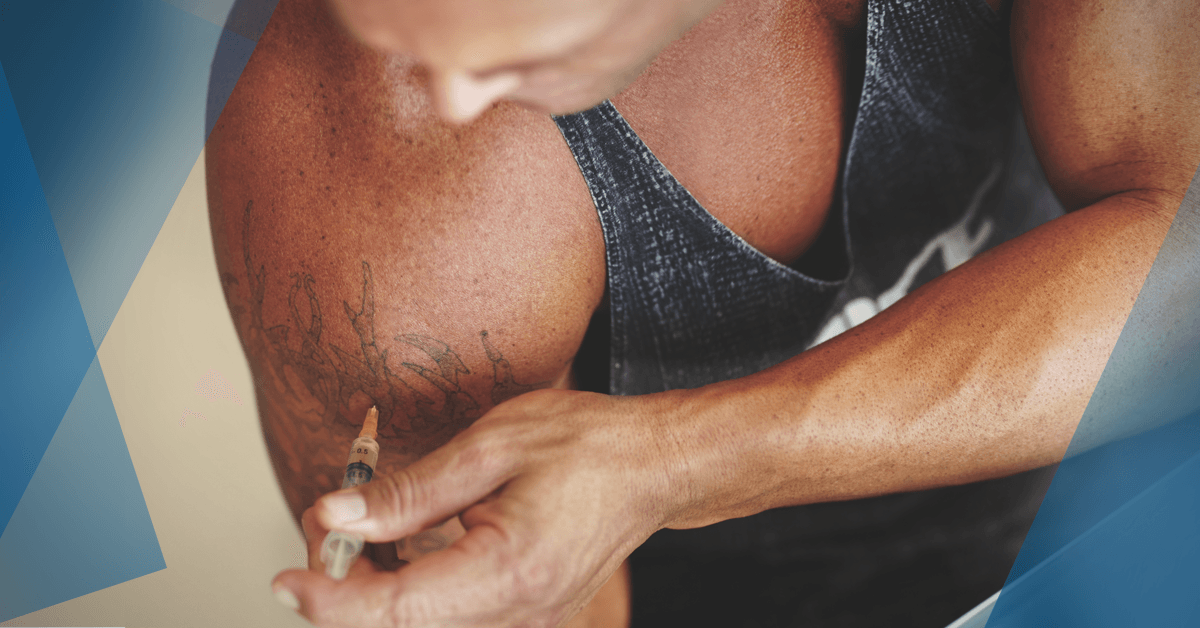If your goal in life is to be a weight-loss guru, a bestselling author, and/or a supplement mogul, you can do it in three easy steps:
1. Fixate on a single hormone or hormone category.
2. Give that hormone credit or blame for everything a potential customer wants to have more or less of.
3. Come up with a training program, diet, and and/or nutritional product to enhance or counteract that hormone’s actions.
Granted, the competition is fierce for anything related to sex, muscle mass, or body fat. But all it takes is one new study—or someone hyping up a really old one—to crank up interest all over again.
Dr. Karl Nadolsky has a simple explanation for why there’s so much interest in molecules that so many of us pretend to understand but so few actually do:
“Hormones are sexy,” he says. “They’ve always been sexy. That’s why I went into endocrinology.”
Nadolsky is a clinical endocrinologist in Grand Rapids, Michigan, who’s also board-certified in internal medicine and a diplomate of the American Board of Obesity Medicine. Before medical school, he was a Division I wrestler at Michigan State, where he qualified for the NCAA tournament all four years.
And before all that, he was a lifter and athlete with an unusual ability to pack on muscle—a trait that got him interested in the endocrine system long before he knew what it was. “I’ve been accused of taking steroids since I was a little kid, even when I was prepubertal,” he says.
That’s why I figured Nadolsky would be the perfect guy to talk to about the most common misconceptions related to hormones, and the ways in which trainers should or shouldn’t talk about them with clients.
He sees the most confusion and misinformation in these three areas:
- Adrenal system
- Thyroid
- Sex hormones
But before we get into the specifics, let’s take a step back and talk about hormones in general, and why they’re so difficult to understand without specialized training.
Blame It on Insulin
Your body manufactures some 50 hormones. It makes them everywhere from your brain to your throat to your sex organs. Your skin, bones, fat cells, muscles, organs, and gut all crank out one or more chemical messengers, each of them telling some part of your body what to do, or stop doing.
Virtually every human activity—eating, sleeping, thinking, moving—triggers, and is triggered by, hormonal signals. “All parts of the endocrine system interact to keep each other in some kind of harmonic balance,” Nadolsky says. “Even doctors don’t understand all the interactive pathways.”
We never think about the endocrine system when it’s all working according to factory specs. But when we suspect something has gone wrong, it’s all we can think about. And that’s where trainers are often too quick to jump into the weeds.
Take diabetes, for example. Those with type 1 diabetes need to take insulin because their bodies are incapable of making enough of it to clear glucose from the bloodstream. “Those patients can tend to gain weight,” Nadolsky says, as a result of nutrient partitioning from intensive insulin therapy. “That’s what some low-carbers use to show that insulin causes weight gain.”
Then there’s the well-known link between obesity and type 2 diabetes, a disease of blood-sugar regulation. One of its hallmarks is a drop in insulin sensitivity. The pancreas has to pump out more insulin initially because the tissues are less responsive, but ultimately fails to keep up. Unless the disease is checked, those patients may also end up needing insulin.
Because insulin and obesity are related, a lot of people have jumped to the wrong conclusion: that carbs, which temporarily raise insulin levels, cause obesity.
“All these things come from some sort of truth that gets altered to fit someone’s narrative,” Nadolsky says.
READ ALSO: How to Help a Client with Type 2 Diabetes
But at least diabetes is a real disease. When fitness pros talk about the adrenal hormones, the conversation often jumps from science to fiction.
Fatigued by the Adrenals
Have you heard of adrenal fatigue? Of course you have. It’s the scourge of modern life:
You burn the candle at all three ends with a high-pressure job, chaotic family life, and all-or-nothing training program. You run on adrenaline and cortisol until, at some point, your adrenal glands give out. You end up chronically tired, stressed, unmotivated, and foggy-brained.
But while the idea of adrenal fatigue makes sense, the diagnosis doesn’t.
“Physicians, naturopaths, and chiropractors, along with trainers and other lay people, sometimes propagate this contention of a disease state called adrenal fatigue,” Nadolsky says. “There is no such pathophysiology.”
Because it’s not a disease, there’s no test for it. And because there isn’t a test for it, anyone can claim a person has it, based on whatever criteria they think that person will find most believable. From there it’s just a short step to an alternative practitioner—well-meaning or otherwise—convincing one of your clients not only that she has it, but that the cure is a special combination of supplements the practitioner just happens to sell.
Your move:
You’re in no position to argue with someone your client considers a medical expert. But you can do three things:
- Share this position paper from the Endocrine Society.
- Recommend that your client get a second opinion, preferably from an endocrinologist like Nadolsky. Because there is a real condition called adrenal insufficiency, she may need more than a good night’s sleep.
- Provide a less taxing training program, one that allows maximum recovery. But no matter how tired she is, encourage her to keep moving.
The Thyroid Challenge
“Thyroid problems are pretty common,” Nadolsky says. An estimated 12 percent of Americans, mostly women, have hypothyroidism—they produce too little of the crucial hormones that affect virtually every part of your body.
Most of them don’t know they have it, either because they don’t have symptoms, or because the symptoms they have—fatigue, lethargy, depression, perhaps weight gain—are often diagnosed as something else. “But because it’s so common, more people think it must be the problem, even when it’s not,” Nadolsky says.
That’s when things get dicey. If a client becomes convinced she has a thyroid deficiency, she may take supplements that contain thyroid hormones. That, he says, can be dangerous, because too much thyroid hormone can lead to bone and/or heart damage, among other problems.
Another issue:
“People think they need to get a lot of tests,” he says, often at the advice of someone who stands to profit from those tests. But tests themselves don’t always show what we think they do.
“A hormone lab evaluation is extremely finicky,” he says. “Even I don’t understand all the nuances. Different lab assays have different problems that make them imperfect. You have to know what factors will change those labs, and what data the ranges are validated from.”
Your move:
- If you think your client may be among the 12 percent with thyroid deficiency, recommend a full evaluation from their primary-care physician or an endocrinologist.
- Exercise and a lower-calorie diet may help someone with hypothyroidism. But if a client tells you she has the opposite, hyperthyroidism, Nadolsky says you definitely want medical guidance before you give her a program.
The Mighty T
Once upon a time in America, it was understood that as men get older, their energy, libido, strength, and muscle mass will decline. That’s how aging is supposed to work. “But now every guy who’s middle-aged and has a little fatigue must have low testosterone,” Nadolsky laments. You can blame any number of suspects:
- Pharmaceutical companies, which market drugs like Androgel directly to consumers.
- “Anti-aging” clinics, which profit from diagnosing hypogonadism—low T—and selling hormone replacements to middle-aged men.
- Gym culture, which rarely sees a problem that a little more testosterone wouldn’t fix.
The fixation begins with a kernel of truth: Natural levels of testosterone really do drop with age. But that doesn’t mean every older guy with lower T needs to have it topped off. In fact, the process of diagnosing hypogonadism is rigorous, and relatively few guys qualify for hormone replacement.
But even more important, Nadolsky says, is to identify the underlying cause of low T, and treat it, if possible.
Unfortunately, that’s not the message a lot of men hear from trainers, especially online trainers. “I honestly don’t understand why anyone would be pushing a specific hormone as a treatment,” he says.
Which is ironic, since trainers can actually do a lot to help those clients raise their endogenous T levels, especially those who are overweight or have obesity. Many of the problems men associate with low testosterone might also be associated with obesity:
- Low energy
- Low libido
- Crummy mood
- Low muscle mass
The solution can be simple, if not easy, Nadolsky says: “Free testosterone goes up with weight loss, and down with weight gain.”
That’s especially true if the man has sleep apnea, a common comorbid condition with obesity. Treating it can help restore his testosterone even before he loses a significant amount of weight.
Your move:
- No matter what your client has been led to believe by friends, trainers, or TV commercials, hypogonadism isn’t something that can be diagnosed by a hobbyist. Even legit lab tests are just numbers on a sheet of paper. “Lab assays for testosterone have traditionally been very poor,” Nadolsky says. “We don’t treat numbers. We treat people.”
- Your training program is a powerful tool. Higher volume is better than lower volume, and heavier weights are better than lighter ones.
Final Thoughts
We’ve only scratched the surface of what these hormones do, or the many ways health problems might arise when one or more of them malfunction, or the limited options trainers have when trying to help clients resolve those problems.
The biggest ones, though, are very much in your toolbox. “All endocrine systems benefit from exercise,” Nadolsky says. Exercise can make a client’s body more sensitive to insulin. It can reduce the fatigue and mood disorders linked to thyroid and adrenal issues. And it can raise testosterone directly.
All those benefits are enhanced with calorie reduction and weight loss. Type 2 diabetes and hypogonadism can be resolved by losing weight and treating related problems like sleep apnea.
Nadolsky shares this advice from Dr. Lou Pangaro, an endocrinologist at Walter Reed National Military Medical Center and his mentor: “Embrace complexity, but act with simplicity.”
So while a trainer’s moves may be limited, the impact of your work isn’t. You can have a dramatic effect on your clients’ health while staying in your lane and letting doctors handle theirs.










